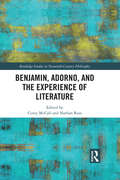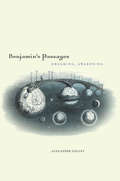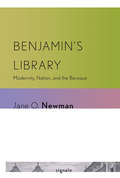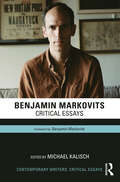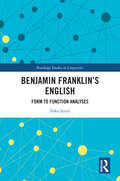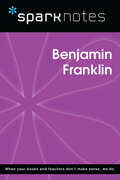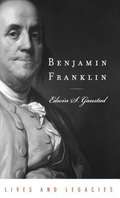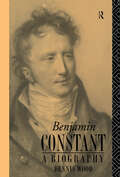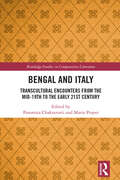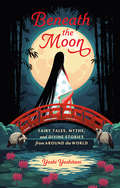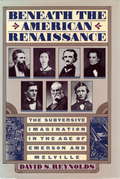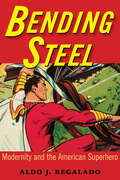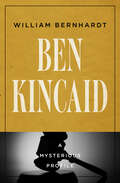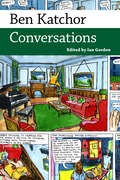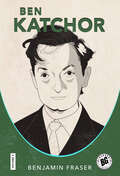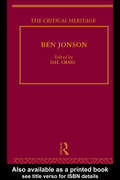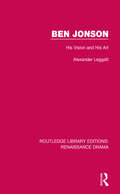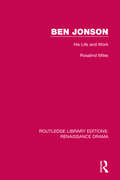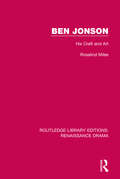- Table View
- List View
Bennewitz, Goethe, 'Faust'
by David G. JohnFritz Bennewitz (1926-1995) was the director-in-chief of East Germany's Weimar National Theatre. Extraordinary in his capacity for cultural and linguistic adjustment, he directed productions in twelve countries, always adapting shows to make them meaningful to local audiences. Notably, Bennewitz conducted stagings of Goethe's Faust in four different languages over a series of seven productions -- three in pre-unification Weimar, one in the reunited Germany, and one each in New York, Manila, and Mumbai.The first comprehensive account of Bennewitz's remarkable career, Bennewitz, Goethe, Faust is also a pioneering study of intercultural interpretations of Faust. David G. John brings to light previously unknown archival materials -- including annotated playbooks, correspondence, translations, videos, and reception information -- as well as unpublished production photos from the stagings discussed in the book. Bennewitz, Goethe, Faust makes a cogent argument for this director's place alongside the twentieth century's greatest theatre innovators.
Benjamin, Adorno, and the Experience of Literature (Routledge Studies in Twentieth-Century Philosophy)
by Nathan Ross Corey McCallThis collection features original essays that examine Walter Benjamin’s and Theodor Adorno’s essays and correspondence on literature. Taken together, the essays present the view that these two monumental figures of 20th-century philosophy were not simply philosophers who wrote about literature, but that they developed their philosophies in and through their encounters with literature. Benjamin, Adorno, and the Experience of Literature is divided into three thematic sections. The first section contains essays that directly demonstrate the ways in which literature enriched the thinking of Benjamin and Adorno. It explores themes that are recognized to be central to their thinking—mimesis, the critique of historical progress, and the loss and recovery of experience—through their readings of literary authors such as Baudelaire, Beckett, and Proust. The second section continues the trajectory of the first by bringing together four essays on Benjamin’s and Adorno’s reading of Kafka, whose work helped them develop a distinctive critique of and response to capitalism. The third and final section focuses more intently on the question of what it means to gain authentically critical insight into a literary work. The essays examine Benjamin’s response to specific figures, including Georg Büchner, Robert Walser, and Julien Green, whose work he sees as neglected, undigested, or misunderstood. This book offers a unique examination of two pivotal 20th-century philosophers through the lens of their shared experiences with literature. It will appeal to a wide range of scholars across philosophy, literature, and German studies.
Benjamin's Passages: Dreaming, Awakening
by Alexander GelleyIn transposing the Freudian dream work from the individual subject to the collective, Walter Benjamin projected a “macroscosmic journey” of the individual sleeper to “the dreaming collective, which, through the arcades, communes with its own insides.” Benjamin’s effort to transpose the dream phenomenon to the history of a collective remained fragmentary, though it underlies the principle of retrograde temporality, which, it is argued, is central to his idea of history.The “passages” are not just the Paris arcades: They refer also to Benjamin’s effort to negotiate the labyrinth of his work and thought. Gelley works through many of Benjamin’s later works and examines important critical questions: the interplay of aesthetics and politics, the genre of The Arcades Project, citation, language, messianism, aura, and the motifs of memory, the crowd, and awakening.For Benjamin, memory is not only antiquarian; it functions as a solicitation, a call to a collectivity to come. Gelley reads this call in the motif of awakening, which conveys a qualified but crucial performative intention of Benjamin’s undertaking.
Benjamin's Library: Modernity, Nation, and the Baroque (Signale: Modern German Letters, Cultures, and Thought)
by Jane O. NewmanIn Benjamin’s Library, Jane O. Newman offers, for the first time in any language, a reading of Walter Benjamin’s notoriously opaque work, Origin of the German Tragic Drama that systematically attends to its place in discussions of the Baroque in Benjamin’s day. Taking into account the literary and cultural contexts of Benjamin’s work, Newman recovers Benjamin’s relationship to the ideologically loaded readings of the literature and political theory of the seventeenth-century Baroque that abounded in Germany during the political and economic crises of the Weimar years. To date, the significance of the Baroque for Origin of the German Tragic Drama has been glossed over by students of Benjamin, most of whom have neither read it in this context nor engaged with the often incongruous debates about the period that filled both academic and popular texts in the years leading up to and following World War I. Armed with extraordinary historical, bibliographical, philological, and orthographic research, Newman shows the extent to which Benjamin participated in these debates by reconstructing the literal and figurative history of sixteenth- and seventeenth-century books that Benjamin analyzes and the literary, art historical and art theoretical, and political theological discussions of the Baroque with which he was familiar. In so doing, she challenges the exceptionalist, even hagiographic, approaches that have become common in Benjamin studies. The result is a deeply learned book that will infuse much-needed life into the study of one of the most influential thinkers of the twentieth century.
Benjamin Markovits: Critical Essays (Contemporary Writers)
by Michael KalischBenjamin Markovits is a leading Anglo-American novelist with a varied and ambitious body of work, ranging from a trilogy of historical fictions on the life of Lord Byron (Imposture, 2007; A Quiet Adjustment, 2008; Childish Loves, 2011) to an award-winning portrayal of a gentrification project in Obama-era Detroit (You Don’t Have to Live Like This, 2015) to intimate studies of contemporary family life (A Weekend in New York, 2018; Christmas in Austin, 2019). Prolific and unpredictable, Markovits is one of the most interesting realist writers working today. Featuring contributions from emerging and established scholars, this collection provides fresh perspectives on Markovits’s place in the contemporary literary field, as well as offering a detailed survey of his work to date. The collection begins with Markovits’s early ‘campus novel’, The Syme Papers (2004), before exploring his celebrated ‘Byron Trilogy’, and the 2005 story cycle, Either Side of Winter. Contributors consider Markovits’s best-known book, You Don’t Have to Live Like This, which won the James Tait Memorial Prize, as well as his more recent fictions focusing on the trials and tribulations of the Essinger family. Taken together, this authoritative collection brings to light the many preoccupations of Markovits’s singular oeuvre—from Byron to basketball, from race relations to real estate. It also includes a frank and wide-ranging interview with the author. The collection will be a first port of call for students and scholars in search of a comprehensive introduction to the work of one of our most exciting contemporary novelists.
Benjamin Franklin's English: Form to Function Analyses (Routledge Studies in Linguistics)
by Yoko IyeiriThis book delves into Benjamin Franklin’s English, illustrating the variable nature of 18th-century American English and his stylistic manipulation of the potentiality of English. Utilizing corpus methodologies, it offers researchers in historical sociolinguistics unique insights.Benjamin Franklin is one of the Founding Fathers of the United States and while his achievements have been well established in the history of America, his linguistic activities have been explored only to a lesser extent. Iyeiri examines his letters and autobiography, which provide linguists with opportunities to study his language. The book is structured using the “form-to-function” framework. The first part focuses on different lexical items one by one, and can be read in the order readers want, whilst in the second part, Iyeiri stitches the arguments together, discussing various grammatical features across different lexical items.This book is a fantastic reference for students and scholars of historical linguistics, varieties of English, and World Englishes.
Benjamin Franklin (SparkNotes Biography Guide)
by SparkNotesBenjamin Franklin (SparkNotes Biography Guide) Making the reading experience fun! SparkNotes Biography Guides examine the lives of historical luminaries, from Alexander the Great to Virginia Woolf. Each biography guide includes:An examination of the historical context in which the person lived A summary of the person&’s life and achievements A glossary of important terms, people, and events An in-depth look at the key epochs in the person&’s career Study questions and essay topics A review test Suggestions for further reading Whether you&’re a student of history or just a student cramming for a history exam, SparkNotes Biography guides are a reliable, thorough, and readable resource.
Benjamin Franklin
by Edmund Sears MorganShort biography of Benjamin Franklin by a historian who has numerous books to his credit along with numerous awards.
Benjamin Franklin
by Edwin S. GaustadThe tenth and youngest son of a poor Boston soapmaker, Benjamin Franklin would rise to become, in Thomas Jefferson's words, "the greatest man and ornament of his age. " In this short, engaging biography, historian Edwin S. Gaustad offers a marvelous portrait of this towering colonial figure, illuminating Franklin's character and personality. Here is truly one of the most extraordinary lives imaginable, a man who, with only two years of formal education, became a printer, publisher,postmaster, philosopher, world-class scientist and inventor, statesman, musician, and abolitionist. Gaustad presents a chronological account of all these accomplishments, delightfully spiced with quotations from Franklin's own extensive writings. The book describes how the hardworking Franklin became at age 24 the most successful printer in Pennsylvania and how by 42, with the help of Poor Richard's Almanack, he had amassed enough wealth to retire from business. We then follow Franklin's nextbrilliant career, as an inventor and scientist, examining his pioneering work on electricity and his inventions of the Franklin Stove, the lightning rod, and bifocals, as well as his mapping of the Gulf Stream, a major contribution to navigation. Lastly, the book covers Franklin's role as America's leading statesman, ranging from his years in England before the Revolutionary War to his time in France thereafter, highlighting his many contributions to the cause of liberty. Along the way, Gaustad sheds light on Franklin's personal life, including his troubled relationship with his illegitimate son William, who remained a Loyalist during the Revolution, and Franklin's thoughts on such topics as religion and morality. Written by a leading authority on colonial America, this compact biography captures in a remarkably small space one of the most protean lives in our nation's history.
Benjamin Disraeli Letters
by Ellen L. Hawman Michael W. Pharand M. G. Wiebe Mary S. Millar Sandra Den OtterIn February 1868 Benjamin Disraeli became the fortieth prime minister of Great Britain. The tenth volume of the Benjamin Disraeli Letters series is devoted exclusively to Disraeli's copious correspondence during that momentous year. The volume contains 648 of Disraeli's letters, 510 of them never before published and all copiously annotated - often with the other side of the correspondence included.This volume constitutes a unique record of Disraeli's rise to power and of the inner workings of the Victorian political scene, all of it recorded in intimate detail. A vast project which the Times Literary Supplement has called "a monument to scholarship," the Benjamin Disraeli Letters volumes are an essential resource for the study of nineteenth-century politics, history, literature, and the arts.
Benjamin Constant: A Biography
by Dennis Wood`For forty years I have defended the same principle: freedom in everything, in religion, in philosophy, in literature, in industry, in politics - and by freedom I mean the triumph of the individual.' Constant thus summarized his beliefs at the end of his life. A political theorist and a passionate defender of individual liberty, he was also the author of one of the greatest French novels of psychological insight, Adolphe. In a major new biography Dennis Wood traces the development of Constant as a writer centrally preoccupied with the problematics of freedom, not only in the fields of politics and religious belief but also in his own troubled relationship with several women.
Bengali (Sahityamela) class 7 - West Bengal Board: সাহিত্যমেলা বাংলা - সপ্তম শ্রেণি
by West Bengal Board of Secondary Education‘সাহিত্যমেলা’ সপ্তম শ্রেণির বাংলা সাহিত্য পাঠ্যবই, যা পশ্চিমবঙ্গ মধ্যশিক্ষা পর্ষদের উদ্যোগে প্রকাশিত। ‘সংস্কৃতি ও বিজ্ঞান’ থিমে নির্মিত এই বইটি জাতীয় শিক্ষাক্রমের রূপরেখা ২০০৫ এবং শিক্ষার অধিকার আইন ২০০৯ অনুসরণ করে। এতে বাংলা সাহিত্যের খ্যাতনামা লেখকদের রচনা, আন্তর্জাতিক সাহিত্যিকদের অনুবাদ এবং ভারতের অন্যান্য রাজ্যের সাহিত্য সংকলিত হয়েছে। বইটি ১১টি অধ্যায়ে বিভক্ত, যেখানে কবিতা, গদ্য এবং গল্পের বৈচিত্র্যপূর্ণ মেলবন্ধন ঘটেছে। ‘হাতে-কলমে’ অংশে রয়েছে শিক্ষার্থীদের সক্রিয় অংশগ্রহণের জন্য বিভিন্ন কার্যক্রম। এছাড়াও, দ্রুতপঠন পুস্তক হিসেবে সংযোজিত হয়েছে লীলা মজুমদারের উপন্যাস ‘মাকু’। শোভাপ্রসন্নের দৃষ্টিনন্দন অলংকরণে সমৃদ্ধ এই বই শিক্ষার্থীদের কল্পনাশক্তি বিকাশ ও সাহিত্যের প্রতি ভালোবাসা জাগাতে সাহায্য করে, বাংলা ভাষা শিক্ষাকে আরও আকর্ষণীয় করে তুলতে সচেষ্ট।
Bengali (Sahityachayan) (First Language) class 9 - West Bengal Board: বাংলা (প্রথম ভাষা) নবম শ্রেণী
by West Bengal Board of Secondary Educationনবম শ্রেণির জন্য বাংলা সাহিত্যের পাঠ্যপুস্তক "সাহিত্য সঞ্চয়ন" বাংলা ভাষা ও সাহিত্যের প্রতি ভালোবাসা জাগিয়ে তুলতে একটি সমৃদ্ধ সংকলন। পশ্চিমবঙ্গ মধ্যশিক্ষা পর্ষদের উদ্যোগে প্রকাশিত এই গ্রন্থটি বিভিন্ন সাহিত্যিক এবং বৈচিত্র্যময় সাহিত্যের সম্ভার নিয়ে সাজানো হয়েছে। বইটি কেবলমাত্র বাংলা সাহিত্যের শ্রেষ্ঠ রচনাগুলির সঙ্গে শিক্ষার্থীদের পরিচয় করায় না, এটি আন্তর্জাতিক ও ভারতীয় সাহিত্যের নির্বাচিত অনুবাদও অন্তর্ভুক্ত করে। পাঠক্রমের সঙ্গে সামঞ্জস্য রেখে প্রস্তুত এই বই শিক্ষার্থীদের কল্পনাশক্তি বিকাশ ও সৃজনশীলতায় অনুপ্রাণিত করে। এতে রয়েছে লেখকদের পরিচিতি, শিখন পরামর্শ, এবং মডেল প্রশ্ন যা শিক্ষার্থীদের সাহিত্যকে গভীরভাবে বোঝার এবং সমালোচনামূলক বিশ্লেষণ করার দক্ষতা বাড়াতে সহায়ক। "সাহিত্য সঞ্চয়ন" শিক্ষার্থীদের বাংলা ভাষার সাহিত্যিক ঐতিহ্যের প্রতি আকর্ষণ তৈরি করার পাশাপাশি তাদের সৃজনশীল দক্ষতা বৃদ্ধির এক অনন্য সহায়ক।
Bengali (Sahayak Path - Praphesara Sankarera Dayeri Banla) (First Language) class 9 - West Bengal Board: সহায়ক পাঠ - প্রোফেসর শঙ্কুর ডায়রি বাংলা (প্রথম ভাষা) নবম শ্রেণি
by West Bengal Board of Secondary Educationনবম শ্রেণির জন্য প্রণীত পাঠ্যপুস্তক "সহায়ক পাঠ - প্রোফেসর শঙ্কুর ডায়রি" সত্যজিৎ রায়ের জনপ্রিয় বিজ্ঞানভিত্তিক কাহিনি সিরিজের ছয়টি নির্বাচিত গল্প নিয়ে গঠিত। কল্পনা ও বিজ্ঞানের চমৎকার মিশ্রণে সমৃদ্ধ এই বইটি ছাত্র-ছাত্রীদের বিজ্ঞানমনস্কতা ও কৌতূহল উদ্রেক করার উদ্দেশ্যে তৈরি। "ব্যোমযাত্রীর ডায়রি" ও "ডক্টর শেরিং-এর স্মরণশক্তি"র মতো গল্পগুলিতে ভবিষ্যৎ প্রযুক্তি, রহস্যময় অভিজ্ঞতা এবং আন্তঃগ্রহ ভ্রমণের গল্প বর্ণিত হয়েছে। সত্যজিৎ রায়ের অঙ্কিত চিত্রশিল্প বইটিকে আরও আকর্ষণীয় করে তুলেছে। এই গল্প সংকলন কিশোর মনে সৃজনশীল চিন্তা এবং সাহিত্যের প্রতি আগ্রহ বাড়ানোর জন্য একটি বিশেষ উদ্যোগ।
Bengal and Italy: Transcultural Encounters from the Mid-19th to the Early 21st Century (Routledge Studies in Comparative Literature)
by Paromita Chakravarti Mario PrayerThe ten essays collected in this book manifest the current global interest for trans-border dialogues and trace the origins and development of Italian and Bengali internationalisms in the period from the mid-19th to the early 20th century. Despite having differing political statuses and lacking a shared geographical or historical space, Bengal and Italy remained uniquely connected and, at times, actively sought to transcend different kinds of constraints in their search for a significant dialogue and mutual enrichment in the fields of literature, music, architecture, art, cinema, diplomacy, entrepreneurship, travels, education and intellectual engagement. In this context, the volume confronts strategies of evaluation adopted by prominent representatives of the Bengali and Italian cultural environments with particular emphasis on readings embedded in the moment of contact. Both regions benefited from this ‘elective affinity’ as they advanced along their respective paths towards a fuller awareness of their specific identity, and thus set a positive example of transcultural understanding which may provide inspiration in today’s world.
Beneath the Moon: Fairy Tales, Myths, and Divine Stories from Around the World
by Yoshi YoshitaniPowerful and universal retellings of seventy-eight divine stories, legends, and myths from around the world, each accompanied by a gorgeous illustration from acclaimed artist Yoshi Yoshitani.Many of the lessons we learn are shared stories passed among cultures and generations. In this riveting collection of fables and folktales from cultures across the globe, characters from beloved fairytales, cultural fables, ancient mythologies, and inspirational deities are brought to life, including Sleeping Beauty (Italy), Rapunzel (Germany), Jack and the Beanstalk (England), Our Lady of Guadalupe (Mexico), Sun God Ra (Egypt), the Crane Wife (Japan), and dozens more. Lesser-known stories introduce characters such as the volcano goddess Pele from Hawaii; Mwindo, the wise and powerful king of the Nyanga people; and the strong and resilient Yennenga, mother of the Mossi people in Burkina Faso. The recurring themes of conquering evil, overcoming adversity, and finding love and companionship are woven throughout this collection.Yoshi Yoshitani's art style is fresh and unique, featuring diverse and multicultural characters. Each story will be featured opposite a correlating illustration, both lush and vibrant.
Beneath the American Renaissance: The Subversive Imagination in the Age of Emerson and Melville
by David S. ReynoldsEmerson, Thoreau, Whitman, Poe, Hawthorne, Melville, Dickinson. In this ground-breaking work, the seven great writers of the American Renaissance are studied together in their literary and social contexts--with a particular view to showing how they assimilated and transformed into literary art the themes and images of popular culture. Their classic works--among them Moby-Dick, The Scarlet Letter, Leaves of Grass, Walden, the tales of Poe--are given strikingly original readings in the rich, often startling, context of long-neglected popular writings of the time. Reynolds especially brings to our attention a whole lost world of sensational literature: pamphlet novels that purveyed hair-raising adventure, reverend rakes, and mythic sea-monsters; gory crime books derived from real-life case histories; reform writings that dwelled on the grisly and perverse results of vice; novels, openly sold on the street, that combined intense violence with explicit eroticism. He shows how this wildly energized popular literature reflected the fantasies and aggressions of Americans in a period of rapid social change--and how it echoes throughout major American works: in the ambiguities of Melville and Hawthorne, in Poe's portrayal of psychopathic killers, in Whitman's open expression of sexuality. Reynolds finds strong traces of such popular types as the fallen woman, the sensual woman, and the feminist criminal recombined in the multifaceted heroines of Hawthorne. He shows how the experimental style and explosive imagery of the sophisticated women's rights novels of the 1850s and the feminist "literature of misery" of the 1850s and 1860s set the stage for Emily Dickinson's work--he sees in her poems closer ties to the popular culture than have previously been revealed. He demonstrates as well how common concerns with issues of religion, slavery, and workers' (as well as women's) rights resonate in the major writings. Throughout, Reynolds uses what he calls "reconstructive criticism" to reveal the social roots of literary texts and to make clear the ways in which cultural images that were crude and formless in their original state were reconstructed and put to the uses of art by the American masters. The result is a landmark study of the richest period in American literary history and a notable contribution to the theory and practice of literary criticism.
Bending Steel: Modernity and the American Superhero
by Aldo J. Regalado“Faster than a speeding bullet. More powerful than a locomotive. Able to leap tall buildings in a single bound . . . It’s Superman!” Bending Steel examines the historical origins and cultural significance of Superman and his fellow American crusaders. Cultural historian Aldo J. Regalado asserts that the superhero seems a direct response to modernity, often fighting the interrelated processes of industrialization, urbanization, immigration, and capitalism that transformed the United States from the early nineteenth century to the present. Reeling from these exciting but rapid and destabilizing forces, Americans turned to heroic fiction as a means of explaining national and personal identities to themselves and to the world. In so doing, they created characters and stories that sometimes affirmed, but other times subverted conventional notions of race, class, gender, and nationalism. The cultural conversation articulated through the nation’s early heroic fiction eventually led to a new heroic type—the brightly clad, super-powered, pro-social action heroes that first appeared in American comic books starting in the late 1930s. Although indelibly shaped by the Great Depression and World War II sensibilities of the second-generation immigrants most responsible for their creation, comic book superheroes remain a mainstay of American popular culture. Tracing superhero fiction all the way back to the nineteenth century, Regalado firmly bases his analysis of dime novels, pulp fiction, and comics in historical, biographical, and reader response sources. He explores the roles played by creators, producers, and consumers in crafting superhero fiction, ultimately concluding that these narratives are essential for understanding vital trajectories in American culture.
Ben Kincaid: Three Ben Kincaid Stories (Mysterious Profiles #5)
by William BernhardtThe &“master of the courtroom drama&” offers a behind-the-scenes look at his New York Times–bestselling legal thriller series (Library Journal). In 1991, William Bernhardt&’s novel, Primary Justice, introduced his character Ben Kincaid to the world. The fictional Oklahoma City lawyer has come a long way since his days as a junior associate at a high-powered law firm. In this essay, Bernhardt guides readers through Ben&’s journey in the long-running series, discussing everything from the development of his character to what&’s next for Ben. Bernhardt also talks about his experience working as a lawyer, getting started as an author, doing research, and navigating the publishing world. Fans of the New York Times–bestselling series won&’t want to miss this fascinating exposé.
Ben Katchor: Conversations (Conversations with Comic Artists Series)
by Ian GordonAuthor Michael Chabon described Ben Katchor (b. 1951) as “the creator of the last great American comic strip.” Katchor’s comic strip Julius Knipl, Real Estate Photographer, which began in 1988, brought him to the attention of the readers of alternative weekly newspapers along with a coterie of artists who have gone on to public acclaim. In the mid-1990s, NPR ran audio versions of several Julius Knipl stories, narrated by Katchor and starring Jerry Stiller in the title role.An early contributor to RAW, Katchor also contributed to Forward, the New Yorker, Slate, and weekly newspapers. He edited and published two issues of Picture Story, which featured his own work, with articles and stories by Peter Blegvad, Jerry Moriarty, and Mark Beyer. In addition to being a dramatist, Katchor has been the subject of profiles in the New Yorker, a recipient of a MacArthur “Genius Grant” and a Guggenheim Fellowship, and a fellow at both the American Academy in Berlin and the New York Public Library.Katchor’s work is often described as zany or bizarre, and author Douglas Wolk has characterized his work as “one or two notches too far” beyond an absurdist reality. And yet the work resonates with its audience because, as was the case with Knipl’s journey through the wilderness of a decaying city, absurdity was only what was usefully available; absurdity was the reality. Julius Knipl, Real Estate Photographer presaged the themes of Katchor’s work: a concern with the past, an interest in the intersection of Jewish identity and a secular commercial culture, and the limits and possibilities of urban life.
Ben Katchor (Biographix #2)
by Benjamin FraserThe recipient of a 2000 MacArthur fellowship, Ben Katchor (b. 1951) is a beloved comics artist with a career spanning four decades. Published in indie weeklies across the United States, his comics are known for evoking the sensorium of the modern metropolis. As part of the Biographix series edited by Frederick Luis Aldama, Ben Katchor offers scholars and fans a thorough overview of the artist’s career from 1988 to 2020. In some of his early strips published in the 1980s in the New York Press and Forward, Katchor introduced one of his quintessential characters, Julius Knipl, a real estate photographer. By crafting Knipl as an urban flâneur prone to wandering, Katchor was able to variously demonstrate his absurd humor and linguistic whimsy alongside narratives packed with social critique. Three volumes collecting the Julius Knipl strips, Julius Knipl, Real Estate Photographer; Cheap Novelties: The Pleasures of Urban Decay; and The Beauty Supply District, helped cement Katchor as a distinguished comics artist and social commentator. Later works, such as The Cardboard Valise, Hand-Drying in America, and The Dairy Restaurant, have diversified his comics legacy. Rooted in close analyses of the artist’s numerous series and collections, each chapter in Ben Katchor is dedicated to a distinct aspect of the urban experience. Individual pages from Katchor’s work depict not only the visual, but also the auditory, tactile, and olfactory dimensions of life in the city.
Ben Jonson: The Critical Heritage (Critical Heritage Ser.)
by D. H. CraigThe Critical Heritage gathers together a large body of critical sources on major figures in literature. Each volume presents contemporary responses to a writer's work, enabling students and researchers to read the material themselves.
Ben Jonson: His Vision and His Art (Routledge Library Editions: Renaissance Drama)
by Alexander LeggattWhile most critical writing on Jonson concentrates on the plays, poems or masques seen in isolation, this title, first published in 1981, ranges across the genres to explore Jonson’s vision as a whole. The author points to the inner connections that make of the rich variety of Jonson’s writing a single coherent body of work. We see Jonson exploring the relations between culture and society, the difficulties of ideal virtue in a far from ideal world, and above all the problems of art itself. Combining a wide-ranging discussion of Jonson’s interests with a detailed examination of his major works, this book provides a balanced critical introduction to one of the most complex and fascinating figures in English Literature.
Ben Jonson: His Life and Work (Routledge Library Editions: Renaissance Drama)
by Rosalind MilesThe extraordinary character of Ben Jonson has only recently been brought into the light. Critics traditionally exalted Shakespeare, at Jonson’s expense. In this biography, first published in 1986, the author presents a full and accurate account of Jonson’s life in modern times. Rosalind Miles follows Jonson from his obscure beginnings to his burial in Westminster Abbey, as the first Poet Laureate, in 1637. Her Jonson is vivid and vigorous, equally alive in his life and in his work. This title will be of interest to students of history, English literature and Renaissance drama.
Ben Jonson: His Craft and Art (Routledge Library Editions: Renaissance Drama)
by Rosalind MilesThough he is one of the undisputed giants of English literature, Ben Jonson is known to most people only as the author of one or two masterly plays which regularly appear in the drama repertory. He is much less well-known for his whole oeuvre, which encompasses poetry, criticism, masque-making, and a lifetime of linguistic and lexicographical study. In this book, first published in 1990, the author presents a comprehensive critical study of the whole of Jonson’s output from his earliest beginnings through to the final achievement. Looking at every word he ever wrote, in drama, masque, poetry, philosophy and literary criticism, the author reveals an interesting and varied picture of Jonson. This title will be of interest to students of English literature and Renaissance drama.

